Remote Mining System M128 GEMSS (USA)
The new principle
By the beginning of the seventies of the last century, the US Army was equipped with several systems for quickly mining the area with several types of explosive devices. Used special artillery shells, cluster aviation bombs and ground devices. These products, in general, met current requirements, but did not always suit the troops. In this regard, in the early seventies began the development of a new land mining system with the required characteristics and capabilities.
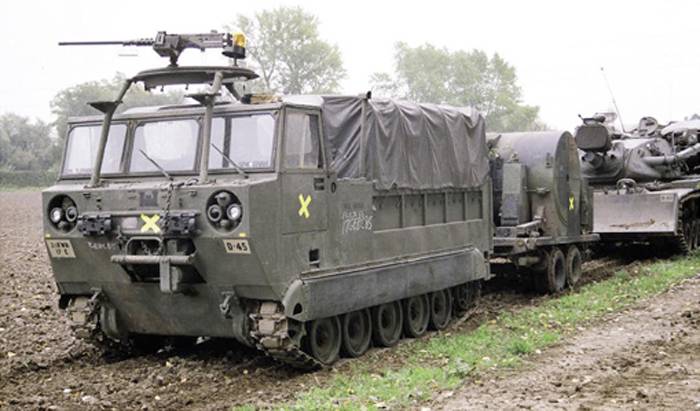
M548 transporter with M128 installation. Photo Tankograd.com
The development of the new model was carried out with the participation of specialists of the engineering troops and was completed in the middle of the decade. In 1975, the new model was adopted under the designation M128 GEMSS (Ground Emplaced Mine Scattering System - "Ground Mine Scattering System"). Soon the army received the required number of new systems and deployed them in areas of alleged conflict. New technology first sent to Europe.
In developing a promising mining system, the unusual principle of scattering mines throughout the territory was used. Instead of pyrotechnic means, it was necessary to use a centrifugal mechanism with an electric drive. The principle of operation of such a facility was to disperse the mine with the help of a rotor and then send it to the field.
The GEMSS system was not particularly complex design. It was proposed to build a towed system on the basis of a wheeled trailer carrying several basic devices. Such a product could be towed by any available equipment and on the move to carry out mining areas. At the same time it was possible to change the main parameters of the barrier. In particular, the density of mining on the front directly depended on the speed of the tractor.
Design
The M128 product was built on the basis of the standard biaxial trailer M794, widely used in the US Army. This trailer was made in the form of a frame with a deck, to which a biaxial undercarriage joined from below. The latter was a cart with spring suspension. A towing device was attached to the trailer frame in front. To stabilize the platform in the parking lot or when performing some operations on the corners of the trailer there were jacks.
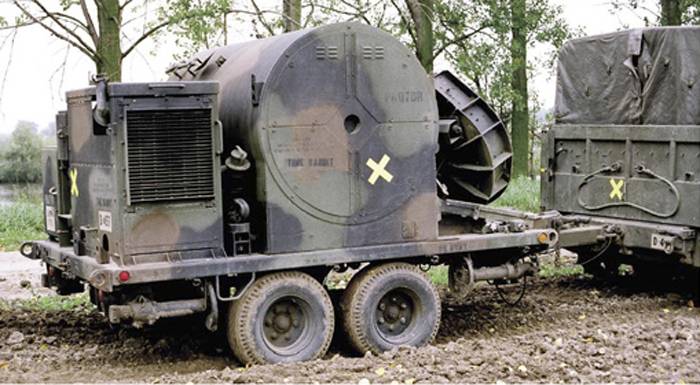
GEMSS system, right side view. Photo Tankograd.com
In front of the trailer placed launcher, providing the release of min. Her "nozzle" was sent back in the direction of travel: the mining system was throwing explosive devices behind her. Behind the launching device there was a large cylindrical housing with a pair of magazines for the transportation of mines and the means to feed them to the launcher. On the back of the trailer, there was a casing with its own power unit, which was responsible for the operation of all other devices. The main body of the installation was made of armor steel of small thickness and provided protection against bullets and fragments.
The launcher of the M128 system had a horseshoe casing with stiffeners, inside which was placed a rotor with its own electric drive. On the bottom, on the back of the casing, was provided a nozzle for feeding mines from the store, and above it, a nozzle for ejecting mines. The installation was placed on a special support with a certain inclination to the right (relative to the direction of movement). The support was equipped with its own drive, with which it had to constantly rotate the launcher around a vertical axis.
For the storage and transportation of mines used a pair of drum shops, placed in a transverse cylindrical body. Shops were placed on the sides of such a hull, in the center - their drives and the system for supplying mines to the launcher. Each store contained 400 min (total ammunition - 800 min). Mines were placed inside a rotating impeller feeder and successively entered the conveyor for feeding to the launcher.
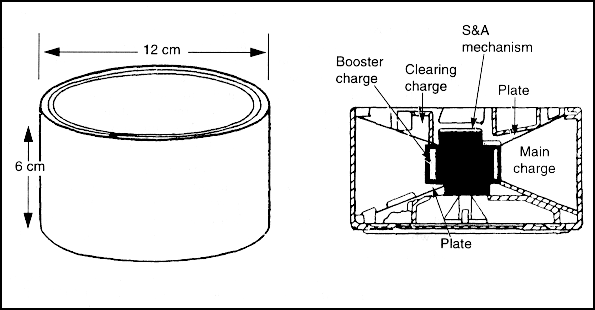
The scheme of anti-tank mines family FASCAM. Figure Fas.org
All the basic mechanisms of the M128 GEMSS mining system were electrically driven. The energy for electric motors was generated by a low-power diesel generator located in the stern of the trailer. Also in the system there was a remote control with which the calculation could control its work.
In terms of overall dimensions, the M128 mining system matched the base trailer. The total height, taking into account all the special equipment, is slightly more than 2,5 m. Own weight of the product is 4773 kg. Gross weight with ammunition from 800 min - more than 6350 kg. The trailer was allowed to tow any available equipment with the required characteristics. There were no towing speed limits on the highway. Speed on rough terrain depended on a number of factors.
Mines FASCAM
The M128 system was supposed to install several types of mines from the FASCAM line (Family Of Scatterable Mines). Depending on the task, the military engineers had to scatter M74 anti-personnel fragmentation mines, M75 cumulative anti-tank or practical M79 anti-tank mines on the ground. All these products had a unified cylindrical body with a diameter of 119 mm and a height of 66 mm.
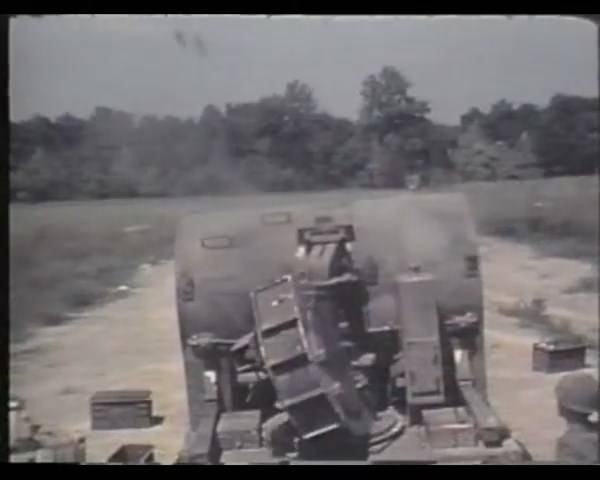
M128 while running. At the top of the frame visible mines flying away. A shot from the newsreel
M74 anti-personnel mine weighed 1,4 kg and carried 410 g of explosive. The M75 anti-tank had a charge in 585 g. Practical ammunition weighed 1,6 kg and could simulate the ballistic parameters of combat. Instead of charge, he carried a weight simulator.
Operating principle
The principle of the GEMSS system was quite simple. Installation of remote mining with the help of a tractor should be carried along the front. The speed of movement was determined in accordance with the required density of mining. Slower speed provided a reduced distance between mines, while its growth contributed to a decrease in density. Using the control panel, the operator could change other parameters of the future minefield.
Suppliers of two drum shops had to constantly rotate and bring mines to a special conveyor. He handed ammunition to the launcher. Inside the latter there was a rotating rotor with its own drive. Under the action of the rotor mine was supposed to pass along the guide wall of the installation. High rotor speed created centrifugal force. Then the mine got to the top branch pipe and under the influence of this force flew out.
The energy of the rotor was enough to accelerate the ejection of a mine over a distance of 50-70 m, depending on its type and mass. The rate of fire of such a system could be set by the operator; Its maximum value is 4 mines per second.
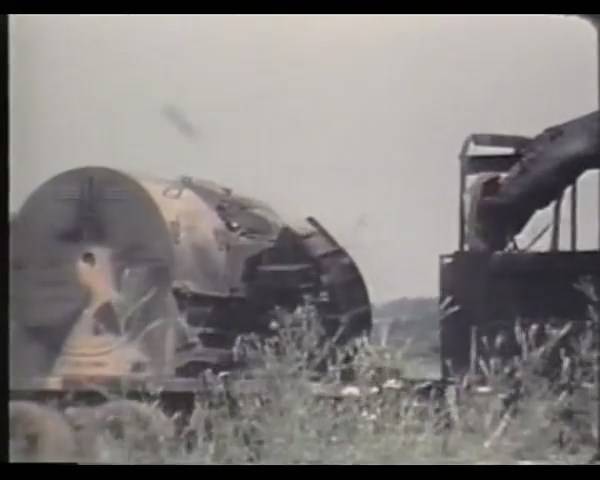
View from a different angle. You can consider a flying mine. A shot from the newsreel
During operation, the launcher could be locked in one position or take turns in different directions. Due to this, mining of a strip of arbitrary width was ensured. In the first case, the mines were scattered in a strip with a width of no more than a few meters. With the maximum deviation of the launcher, the mine flew away to the 30-50 m from the line of motion.
Using two full-time magazines with 800 mines and observing the optimal speed, the M128 installation could organize a barrier with the dimensions 1000х60 m in one pass. By changing the rotor speed or trailer speed, the minefield parameters could be affected. In this case, excessive speed or reduced rate of fire could damage the installation density of min.
In service
The FASCAM family of mines was put into service in 1975. Soon, the M128 GEMSS remote mining installation was also adopted. Over the next few years, dozens of such products were manufactured in the interests of the US engineering forces. New equipment was distributed between sapper battalions tank and motorized rifle divisions. This unit was supposed to have 8 units.
The first new engineering systems received compounds deployed in Europe. According to known data, American connections at European bases received and deployed 69 installations GEMSS. A similar number of similar devices remained in the United States. Engineering equipment was regularly used as part of combat training. The M128 calculations went into the field of training battles and carried out conditional mining of the area using inert M79 mines. During service, the M128 systems never had to participate in a real operation and organize mine blast barriers in the enemy's way.
The active operation of GEMSS systems continued until the early nineties, when it was decided to replace them with other samples. The developed mining tools lost M128 in terms of ammunition size and main characteristics, but were lighter and more compact. From 1991, new remote mining equipment compatible with mines of the FASCAM family began to come into service with US engineering units. The emergence of these products has launched a gradual write-off of obsolete GEMSS.
The process of decommissioning and decommissioning of engineering systems lasted for several years and ended in 1995. According to different sources, part of the M128 GEMSS products was saved and sent to storage. Other mining systems were disposed of as unnecessary.
Advantages and disadvantages
The M128 Ground Emplaced Mine Scattering System, a towed remote mining system, was an interesting example of engineering technology capable of quickly and efficiently organizing mine-explosive obstacles. The installation was distinguished by a rather simple design, but at the same time it carried a large stock of mines, could use ammunition of various types and disperse them over a large area. All these factors led to the fact that at one time M128 was adopted and received a certain distribution.
However, the product GEMSS was not without flaws. Its main problem could be considered the size and weight, imposing certain restrictions on operation. Thus, the installation needed a tractor capable of towing a trailer weighing more than 6 tons, including over rough terrain. The presence of a large and heavy trailer to some extent worsened the mobility of the demining battalion or company. When mining on the way of the enemy, the trailer could attract attention and become an easy target.
Known about some of the difficulties associated with the use of centrifugal launchers and drum magazines. The composition of these devices was attended by a significant number of moving parts, which led to the risk of damage to mines at different stages of the mechanism. In addition, there were problems with the reliability of stores.
The mines used in the FASCAM range to some extent complicated the operation of the installation. Due to the characteristic working procedure, the M128 system could not be used in some locations. Mines could not be thrown on hard ground or other surfaces that could damage them when dropped. The presence of vegetation, snow cover or other interference interfered with the normal installation, and could also lead to premature self-destruction of ammunition.
The remote mining system M128 GEMSS was one of the most interesting examples of US engineering technology. It implemented unusual ways of working with ammunition, which provided high performance. However, obtaining the desired capabilities was associated with a number of difficulties and problems. In this regard, M128 has given way to newer mining systems that use other operating principles.
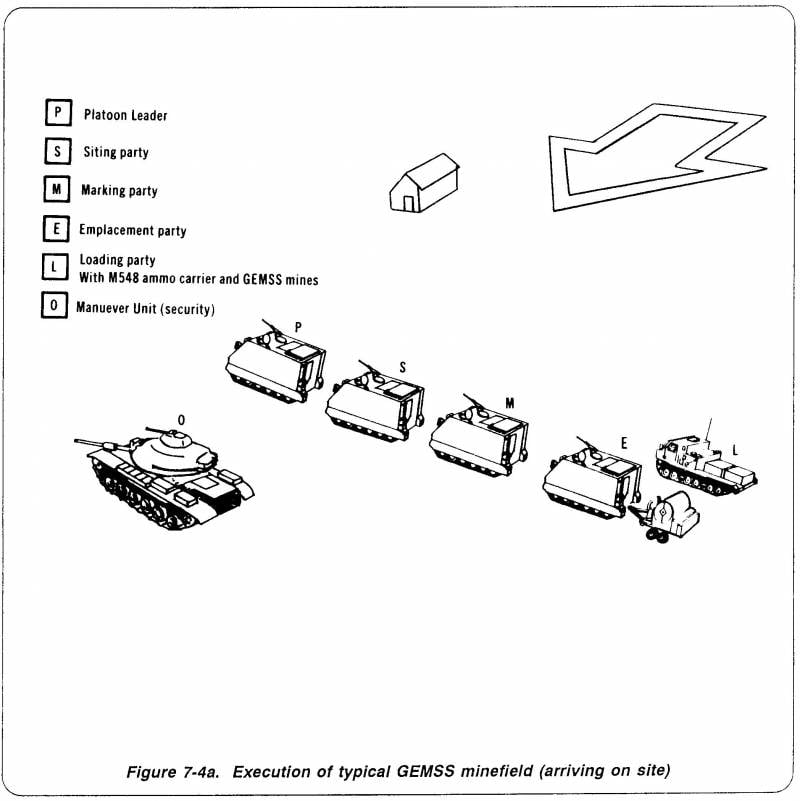
Information